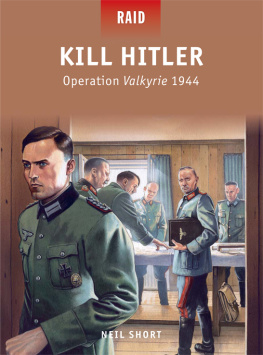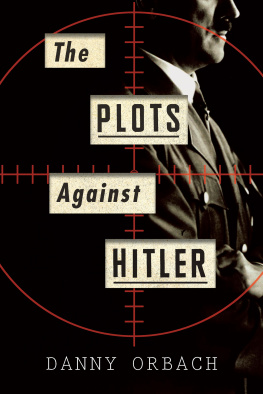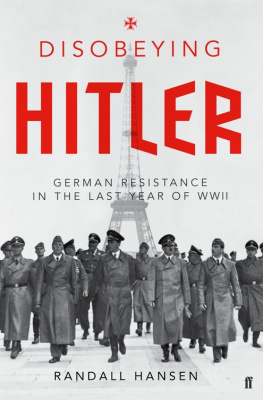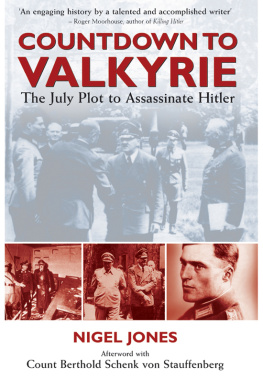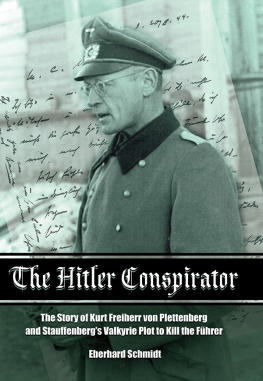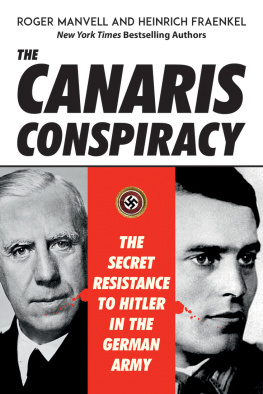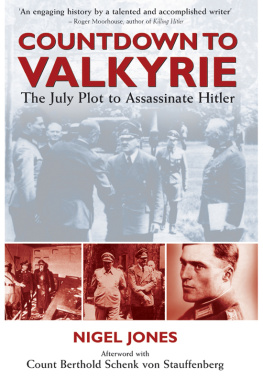BEHIND VALKYRIE
GERMAN RESISTANCE TO HITLER
Documents
Edited by Peter Hoffmann

Translation by Peter Hoffmann, with assistance from Kyle Jantzen,
Kenneth Reynolds, Katharine Sams, and Andrew Szanajda
This edition McGill-Queens University Press 2011
ISBN 978-0-7735-3769-9 (cloth)
ISBN 978-0-7735-3770-5 (paper)
Legal deposit first quarter 2011
Bibliothque nationale du Qubec
Printed in Canada on acid-free paper that is 100% ancient forest free
(100% post-consumer recycled), processed chlorine free
This book has been published with the help of a grant from the Canadian Federation for the Humanities and Social Sciences, through the Aid to Scholarly Publications Programme, using funds provided by the Social Sciences and Humanities Research Council of Canada.
McGill-Queens University Press acknowledges the support of the Canada Council for the Arts for our publishing program. We also acknowledge the financial support of the Government of Canada through the Canada Book Fund for our publishing activities.
LIBRARY AND ARCHIVES CANADA
CATALOGUING IN PUBLICATION
Behind Valkyrie : German resistance to Hitler : documents / edited by Peter Hoffmann.
Includes bibliographical references and index.
ISBN 978-0-7735-3769-9 (bound).
ISBN 978-0-7735-3770-5 (pbk.)
1. Anti-Nazi movement Germany History Sources.
2. Government, Resistance to Germany History 20th century Sources. 3. Germany Politics and government 19331945 Sources. I. Hoffmann, Peter
DD256.3.B45 2010 943.086 C2010-905415-6
Set in 9.7/13 Calluna and 9.7/13 Baskerville 10 with Futura
Book design & typesetting by Garet Markvoort, zijn digital
To My Students
CONTENTS
ACRONYMS
BDM | Bund Deutscher Mdel | Federation of German Girls |
DC | Deutsche Christen | German Christians |
DNVP | Deutschnationale Volkspartei | German National Peoples Party |
HJ | Hitler Jugend | Hitler Youth |
NSDAP | Nationalsozialistische Deutsche Arbeiterpartei | |
Nationalist Socialist German Workers Party, Nazi Party |
NSFK | Nationalsozialistisches Fliegerkorps | |
National Socialist Flying Corps |
NSKK | Nationalsozialistisches Kraftfahrkorps | |
National Socialist Motoring Corps |
NSV | Nationalsozialistische Volkswohlfahrt | |
National Socialist Peoples Welfare |
OKH | Oberkommando des Heeres | Army High Command |
OKW | Oberkommando der Wehrmacht | Armed Forces Supreme Command |
SA | Sturmabteilung | Stormtroopers or Brown Shirts |
SPD | Sozialdemokratische Partei Deutschlands | |
Social Democratic Party of Germany |
SS | Schutzstaffel | Protection Squadron |
ACKNOWLEDGMENTS
The editor thanks all copyright holders for permission to publish translations of the documents included in the present volume. He also thanks the archivists, most of all Professor Hartmut Weber, president of Bundesarchiv, and the librarians in the many institutions in which he pursued research relative to the entries in this volume for their dedicated help in locating many of the works referenced in the notes, and equally Susan Pelland, his copy editor, for applying stringent standards, and Eliza Wood for her help in the preparation of the index. The editor is grateful to the Landesstiftung Baden-Wrttemberg and to Horst von Oppenfeld for financial support.
BEHIND VALKYRIE
INTRODUCTION
One of the most difficult tasks for students of history is to see historical events and persons as their contemporaries saw them. Students must attempt to know and understand what those of another time knew and understood. They must attempt to know as fully as possible the historical situation and state of information. If their own experiences are not sufficiently similar to those of the persons they study, they must dissect the experiences into components with which they can identify. For example, in order to approximate the experiences of a soldier in the trenches in the First World War, students may imagine themselves being in rain and mud for days without an ability to get dry or change clothes; they may add shell shock, loss of comrades, fear of death. In order to comprehend what the persons they study were doing, they must understand the context, and they must understand what their subjects thought they were doing. Every selection in this book demands this effort. The next most difficult task is to learn what the actors in fact did and what effects their actions had.
Students need for original sources in order to accurately grasp past events and persons motivates the first principle behind this book. The value of whole documents, where only fragments or none were available in print before, motivates the second.
The documents in this book provide an immediate approach to the most disturbing epoch in twentieth-century German history the twelve years of Adolf Hitlers and his National Socialist German Workers Partys rule.
In the police-state conditions in which the German people lived during Hitlers rule, opposition was repressed or crushed by the secret state police or Gestapo (Geheime Staatspolizei), which, through a vast network of informers, reached into virtually every household. People who carried on conversations critical of the regime, even if they only referred to a shortage of certain goods, tended to cover their telephones with pillows, as it was rumoured that the Gestapo could listen in. During the war, harsh penalties, in some cases death sentences, were imposed by Special Courts (Sondergerichte) for tuning in to neutral or enemy radio stations, this act being considered treasonous. When a neighbour suddenly disappeared, and someone had seen two men in leather coats take him away at 5:00 a.m., the rumour of it struck fear into people. The existence of concentration camps was officially acknowledged, but former inmates were forbidden to talk about their experiences, enhancing the sense of the sinister. At the same time, through guards and their families, as well as former inmates, a great deal of information about beatings and killings did leak out and deepened the atmosphere of terror. The sense of ubiquitous surveillance was exaggerated, but uncertainty prevented easy communication. Opponents of the regime had little opportunity to inform themselves of events inside and outside Germany, or to discuss them and form opinions in the way one is accustomed to do in a free society.
From the first days of his reign, Hitler abrogated individual liberties and put in place the policing and judicial machinery of terror. On 17 February 1933, Hermann Gring, as Interior Minister of Prussia, which amounted to about two-thirds of Germany, decreed: Communist terrorist acts and attacks must be met with all severity and, when necessary, with ruthless use of weapons. I shall cover for police officers who use firearms in the discharge of these duties regardless of the consequences of the use of firearms. Those who display weakness, however, will be subject to disciplinary action. This shooting decree was published verbatim on the front page of the National Socialist Party daily newspaper,







